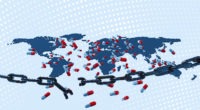Supply-Chain Digitalization: Senior Executives Weigh in on the Opportunities and Challenges
Increasing the use of digital technologies, such as artificial intelligence, blockchain, and predictive analytics in supply-chain operations is a priority for many executives. Senior executives weigh in on the opportunities and challenges.
Becoming digital first in supply-chain operations
The value of advancing digital technologies such as artificial intelligence (AI), blockchain, predictive analytics, has taken on greater importance as the Bio/Pharma industry, along with other industries, grapple with supply-chain challenges that emerged during the pandemic and that continue today. The pandemic not only exposed supply-chain vulnerabilities but also has caused companies to re-evaluate their supply chains and address existing inefficiencies and ways to improve supply-chain performance.
So-called “digital-first” supply chains was cited as one of the top three characteristics by the Gartner Group, a research and advisory group, in putting together its annual rankings of the Top 25 Supply Chains in 2021. An integrated-purpose-driven organizations and customer-driven business transformation were the other two.
A Gartner survey of board of directors, taken late in 2020, showed that nearly 70% of companies accelerated their digital roadmaps during the pandemic. “Some leading supply chains have reached a point in their transformation journey where they consider themselves ‘digital first’ in the use of technology to enable more seamless customer experiences and more automated and insightful decisions in supply and product management, at scale,” according to the Gartner analysis.
The Gartner analysis emphasizes that digital transformation would not be possible without the right talent. It points to leading companies conducting formal skills assessment and strategic workforce planning. AI, machine learning, and Big Data analysis are the most common capabilities, and most are simultaneously recruiting and developing these skills in their organizations, according to the analysis. The study points to several advanced supply-chain organizations running digital literacy and dexterity programs to enable employees to better understand and exploit digital business opportunities.
“Leaders must position new digital technologies as a means for employees to stop spending time on manual, non-value-added activities, so they can focus on providing value for their customers,” said Mike Griswold, Vice President and Team Manager with Gartner’s Supply Chain Practice, in commenting on the Top Supply-Chain rankings when released in August 2021.
A Pulse Survey, conducted by the management-consulting firm, PwC, of more than 650 executives earlier this year (January 2022) asked what they see as the most significant issues in their growth strategy; 60% said that digital transformation is their most important growth driver. Almost a third (32%) of executives foresee continued supply-chain disruptions, which are leading companies to evaluate alternative sourcing strategies, from policy shifts to opportunities to digitize supply chains.
In addition, a separate PwC survey, the PwC Digital Trends in Supply Chain Survey, fielded November 2021 to January 2022, surveyed 244 operations and information technology leaders, C-suite executives, and other supply-chain officers from companies in select supply-chain-intensive sectors to assess how they are addressing supply-chain management operating models, including the use of enterprise and emerging technologies. Sectors surveyed included chemicals and other manufacturing and industrial products; pharmaceuticals and life sciences; consumer markets and retail; energy, utilities and mining; aerospace; automotive; and technology, media and telecommunications.
Although increasing efficiency and managing or reducing costs in supply-chain operations topped the list of priorities over the next 12-18 months, ranked as the number one priority by respectively by 63% and 59% of respondents, digitalization of the supply chain was also cited as an important issue but talent gaps are on issue. Twenty-one percent cited a need to better automate and improve analytics in their supply chains, and 19% cited increasing the digital skill sets of employees as a top priority. Many companies—58% of respondents—are seeing higher than normal supply-chain employee turnover, and only 23% fully agree that they have the necessary digital skills to meet future goals. Most also expect to make changes to their operational systems in the next year.
As companies continue to digitalize supply chains, budget constraints have been the biggest hurdle, with nearly half of respondents ranking it among their top three challenges, according to the PwC study. Talent and technology have posed problems with digitalization in various ways. Three out of ten cited difficulty getting employees and teams to work differently as a top-three challenge while nearly a quarter pointed to difficulties with the “digital native” talent needed to transform supply chains. On the technology side, a lack of understanding of business and technical capabilities and software and hardware shortcomings with analytical and process capabilities also were cited as top challenges.
DCAT Week program focused on the digital supply chain
A special DCAT Week program, Supply Chain Digitalization, Business Analytics & Technology Applications held on March 23, 2022 provided practical insights on how companies are using digital technologies, such as AI, blockchain, and predictive analytics, now and in the near term, and with that, how expectations between customers and suppliers are evolving.
The program was the inaugural program of a partnership between DCAT/the DCAT Supply Management Committee and the Broad College of Business, Michigan State University (MSU), and its top-ranked Supply Chain Management (SCM) program. The faculty members in MSU’s Department of Supply Chain Management are thought leaders in the SCM field and are on the forefront of what is happening in SCM across all industries. DCAT is planning additional online programs as part of its partnership in 2022.
Dr. Cheri Speier-Pero, the Ernst & Young Professor in Accounting and Information Systems, and Associate Dean for Undergraduate Programs, Eli Broad College of Business, Michigan State University, provided a presentation and led an engaging audience Q&A.







